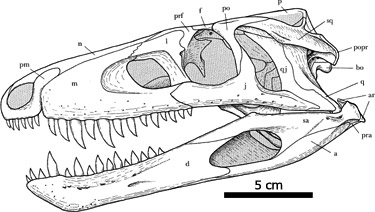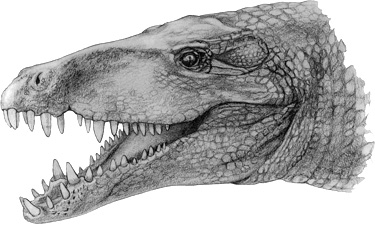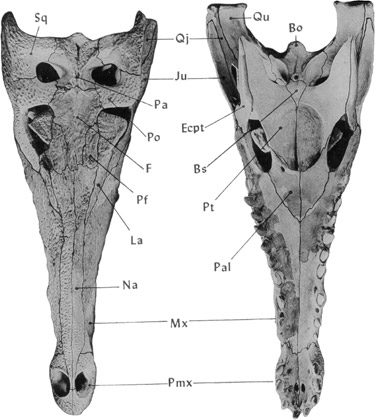
Crocodylomorpha
Crocodiles and their relatives
When you think of crocodiles, "diversity" is probably not the first word that pops into your head. There are only about 20 living species of crocodilians, and they all look roughly the same and lead similar lives. Despite the differences between the long-snouted gavials, which eat mostly fish, and the wide-snouted alligators, which take crunchier prey, you are not likely to mistake a croc for anything else. There are no long-legged running crocodiles or deep-diving ocean crocs; no crocs the size of chihuahuas and none the size of T. rex, either; and no living croc has blade-like teeth or eats plants. But that was not always the case.
After their evolutionary line split from those of other pseudosuchian archosaurs in the Triassic Period, crocodylomorphs — the group that includes today's crocodiles and their close relatives — explored a variety of niches. They did not immediately retire to the swamps and rivers to take up a life of catching fish. Although living crocs may not be very diverse, they are widespread, occuring in tropical and subtropical habitats worldwide. However, living crocs are just one tiny twig in the evolutionary tree of crocodylomorphs. They are not representative of the diversity of the entire group, just as birds are not representative of all dinosaurs.

 Lateral view of the skull of Sphenosuchus. |
Fossils of sphenosuchians have been found in North Carolina and in several western states, and in Argentina, Brazil, England, Germany, South Africa, and China. The earliest sphenosuchians appeared in the Triassic Period. Although most groups of pseudosuchian archosaurs went extinct near the end of the Triassic, sphenosuchians survived at least until the Middle Jurassic. One unusual sphenosuchian is Redondavenator from New Mexico. Although the fossils are incomplete, Redondavenator was a very large animal with a skull at least two feet long. It lived at the very end of the Triassic Period. By this time the rauischians were already extinct, but large carnivorous dinosaurs had not yet appeared. Redondavenator probably filled the large land predator niche following the disappearance of the rauisuchians and before the evolution of large theropod dinosaurs such as Dilophosaurus.
In the past few years, most researchers have found that some sphenosuchians are more closely related to other crocs than they are to other sphenosuchians. That means that sphenosuchians do not form a natural group — they did not all share the same common ancestor to the exclusion of other kinds of crocodilians. This is important because it tells us something about the ancestors of living crocodiles. If sphenosuchians formed a separate group, then the attributes that characterize some or all them, such as small size, long legs and terrestrial habits, might have evolved only in that group. But if sphenosuchians are not a natural group — if they are spread out along the base of the evolutionary tree of crocs — then it means that the ancestors of all later crocodiles went through a phase in which they were small running animals that lived on land. It means that we can't look at crocs today and say, "This is what primitive archosaurs are like," because living crocs are not like primitive archosaurs. In fact, they're not even like primitive crocs. Living crocs are not big, slow-moving, semi-aquatic animals because they are primitve. Those characters are evolutionary adaptations for their current way of life. In their own way, living crocodiles are just as weird and specialized as birds, and it is a mistake to think of them as primitive.
 Dorsal and palatal views of the skull of Sphenosuchus. |
Crocodyliforms
The rest of the crocodylomorphs were traditionally arranged into various grades of "advancement" as they approached living crocs in their form. First were the "protosuchians" or primitive crocs, which were the least like living crocs. Then came "mesosuchians" or middle crocs, which were more like living crocs than protosuchians, but still had some important differences. Finally there were "eusuchians" or true crocs, which consisted of living crocs and their closest, most croc-like relatives.
Modern classifications are arranged based on common ancestry, but the old groupings have turned out to be pretty stable. It is not clear whether "protosuchians" form a natural group or not — that is, whether they share a more recent common ancestor with each other than with living crocs — but the various protosuchians are the most primitive crocodyliforms. Protosuchians were between one and two meters long and they seem to have been adapted for life on land and in the water. None of them got very big, and they didn't dabble in any of the weird adaptations of other croc lineages, like diving in the ocean or eating plants. But protosuchians survived through the Jurassic and into the Lower Cretaceous Period, by which time many other groups of archosaurs had come and gone.
The old "mesosuchians" have joined eusuchians in the clade Mesoeucrocodylia (ME-zoh-you-CROC-uh-DILL-ee-uh). If the eusuchians are "good" crocs — animals that, for the most part, looked and acted like living crocodilians — then the other mesoeucrocodylians are the ones that break all of the rules. Noteworthy mesoeucrocodylians include the thalattosuchians, Sebecus, and notosuchians.
Thalattosuchians
Thalattosuchians were a diverse group of ocean-going crocs that flourished in the Jurassic Period. The living saltwater croc (Crocodylus porosus) of Southeast Asia and Australia is a powerful swimmer that can cross dozens or hundreds of miles of open ocean. But these are trips from one landmass to another — saltwater crocs don't live in the open ocean. Thalattosuchians did, and they were very well adapted for that lifestyle. They had very long, slender bodies and paddle-like limbs, and some even had a vertical fin at the end of their tails, like that of a shark or an ichthyosaur. Animals that dive deep in the ocean, like whales and seals, tend to have very porous bones. Some thalattosuchians also had porous bones, which means that they probably spent most of their time in the ocean. They may have come onto land to lay eggs, like sea turtles, but this is one aspect of thalattosuchian biology for which we have no data yet. The extinction of this widespread and successful group at the end of the Jurassic Period is equally mysterious.
 A reconstruction of the head of Sebecus.  Dorsal and palatal views of the skull of Sebecus. |
The answer turned out to be no, but the owner of the teeth turned out to be almost as strange as a late-surviving predatory dinosaur would have been. It was a large crocodile, which was named Sebecus after the crocodile-headed god of ancient Egypt. No one ever expected to find theropod-like teeth in a croc. Almost all crocodylomorphs have cone-shaped teeth. Cone-shaped teeth are good for puncturing prey and for holding onto slippery fish. They are also very strong, which is good, because crocs have incredibly powerful jaw muscles that can exert tremendous pressure. In the history of life, only tyrannosaurs had a more powerful bite, and they also had fat, round teeth. In addition to its thin, blade-like teeth, Sebecus also had a long, tall, narrow snout, much like the face of a theropod dinosaur. In the early part of the Cenozoic Era, South America had few large mammalian predators. Large flightless birds with fearsome hooked beaks filled the large predator roles instead. These birds may have shared the job of terrestrial predator with Sebecus. Its skull and teeth are more like those of a land predator than one that lives in the water. Unfortunately, the rest of the skeleton is only known from fragments, and they are not complete enough to show for certain whether Sebecus lived on land or in the water. Hopefully this question will be answered when more fossils come to light.
Notosuchians
Sebecus is a weird croc, but it's only a little weird compared to the notosuchians. These were small, heavily armored animals, with heads that were bulldog-short and mouths full of multicusped, mammal-like teeth. They lived on land and ate plants. That's right, plant-eating crocs! Notosuchians were widely distributed in the Cretaceous Period and include Uruguaysuchus from South America, Malawisuchus from Africa, Simosuchus from Madagascar, and Chimaerasuchus from China. Like Sebecus, notosuchians also seem to have evolved convergently with dinosaurs. Only instead of resembling theropods, notosuchians looked like the armored ankylosaurs. This is particularly interesting because no ankylosaur fossils have been found in South America, Africa, or Madagascar. Notosuchians seem to have filled the same niche on the southern continents that ankylosaurs occupied on the northern continents. And like ankylosaurs, they went extinct at the end of the Cretaceous Period.
You can find CT slices and a 3D model of the skull of the notosuchid crocodyliform Simosuchus at the DigiMorph website.
Eusuchians
The final group of mesoeucrocodylians is the eusuchians or "true crocodiles," and they are described on a separate page.
In general, mesoeucrocodylians illustrate the adaptability of Crocodyliformes to many different modes of life. And they serve as a reminder that, although they are successful, living crocs are still a comparatively tiny remnant of a group that was once much more diverse.
Sources
|
||
Text by Matt Wedel, 5/2007. Sphenosuchus images used with permission of the Royal Society of London: from Walker, A.D. 1990. A Revision of Sphenosuchus acutus Haughton, a crocodylomorph reptile from the Elliot Formation (Late Triassic or Early Jurassic) of South Africa. Philosophical Transactions of the Royal Society of London, B 330:1–120. Sebecus images courtesy Department of Library Services, American Museum of Natural History: from Colbert, E.H., G.G. Simpson, and C.S. Coleman. 1946. Sebecus,representative of a peculiar suborder of fossil Crocodilia from Patagonia. Bulletin of the American Museum of Natural History 87:221-270.